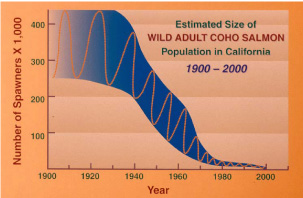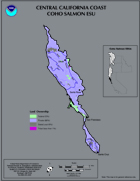Salmonid Limiting Factors

Over the past 70 years, native coho populations have declined more than 99% along the Central California Coast coho range.
NOAA estimates that during the 1960s there were 4,000 spawning adults in the Gualala. This population decreased to 200 in the early 1990s and today there are indications that Coho could become extirpated from the Gualala.
The core refugia planning watersheds for Coho are Doty Creek and Stewart Creek in the North Fork SPW and Pepperwood Creek in the South Fork SPW.
Watershed Causes of Salmonid Population Decline
Salmonid populations in California and throughout the Pacific Northwest have experienced significant declines as compared with historical data, as result of multiple factors including widespread expansion of land and water uses, disease, ocean harvest, and predation (Nehlsen et al. 1991).
Watershed habitat loss and modification are believed to be a major factor determining the current status of salmonid populations. Conservation and recovery of Pacific Northwest salmon and steelhead depend on having diverse habitats with connections among those habitats.
Loss of habitat reduces the diversity in salmon and steelhead life histories, which influences the ability of these fish to adapt to natural and man-made changes (NMFS 2006).
Sediment
Amplified sediment loads are a major contributing factor to the decline of historic runs of salmon and steelhead in the Gualala River.
Human activities have increased in-stream sediment causing the loss of deep pools, decreasing the quality of spawning gravels and increasing turbidity during high flows. Aggradations of the streambed has simplified channel form and in some areas of our rivers, sediment is the cause of decreased or non-existant surface flows during the low flow season.
Temperature
Salmonid feeding, growth, resistance to disease, competitive ability, and predator avoidance are impaired by unsuitable water temperatures.
Differences in geology, hydrology, stream aspect, stream flow, relative ground water contribution, canopy, and climate all have an influence on water temperature.
Although water temperature data have only been available since the early 1990s, it is understood that water temperatures have risen over the past century. The main causes of elevated temperatures are increased sediment loads and decreased canopy cover in the tributaries of the Gualala.
Canopy cover was complete in most tributaries in 1942 indicating advanced regeneration from the original old growth logging along the South Fork and lower to middle reaches of the North Fork. By 1968 large-scale block clearance timber harvest projects entirely eliminated overstory shade canopy over most salmonid spawning ground. This has resulted in an increase in the amount and intensity of solar radiation.
Excess sediment may contribute to elevated water temperatures. Accumulated sediment fills pools and causes the width of a channel to increase, thereby becoming shallower, which can facilitate heat exchange.

